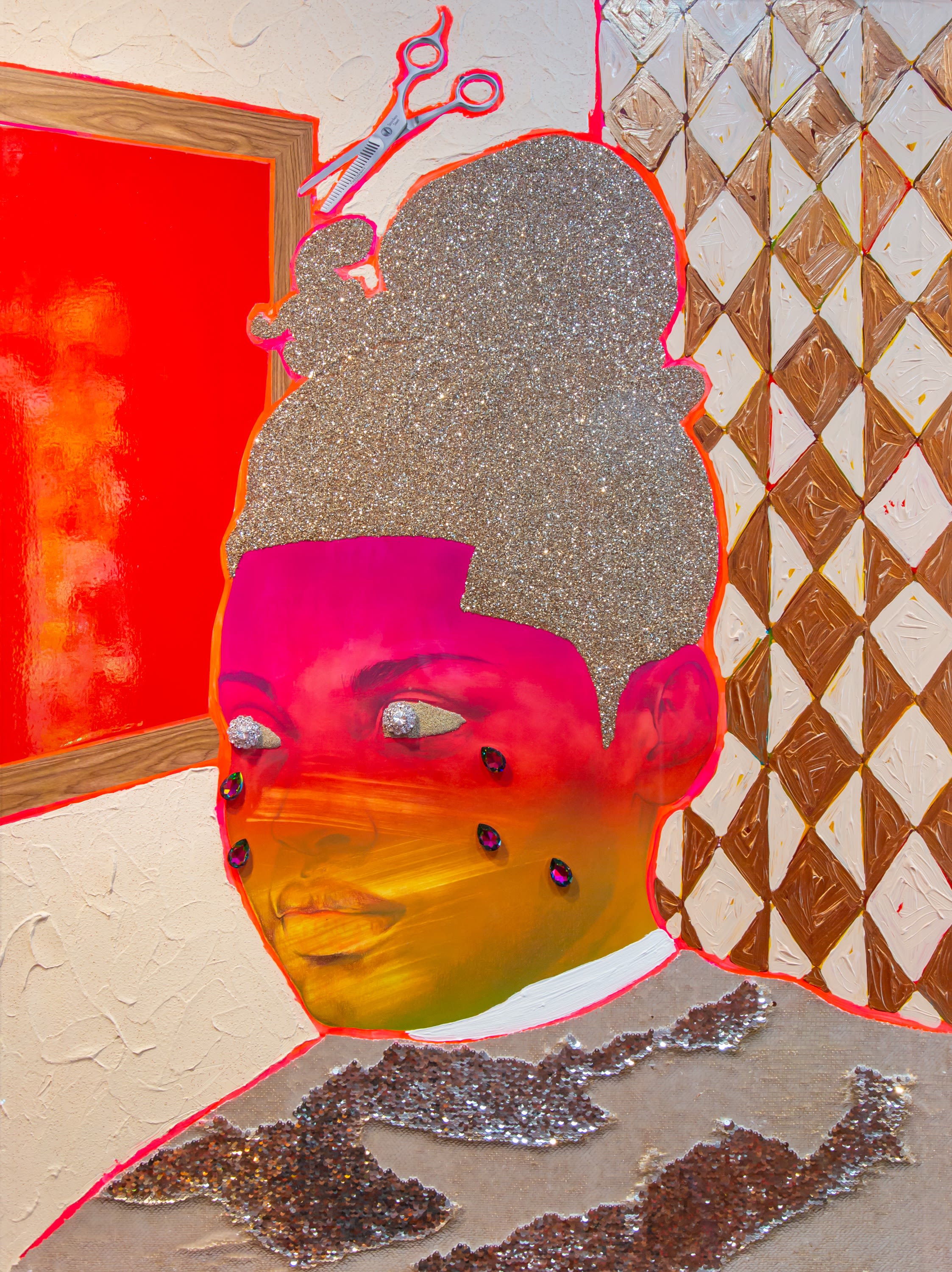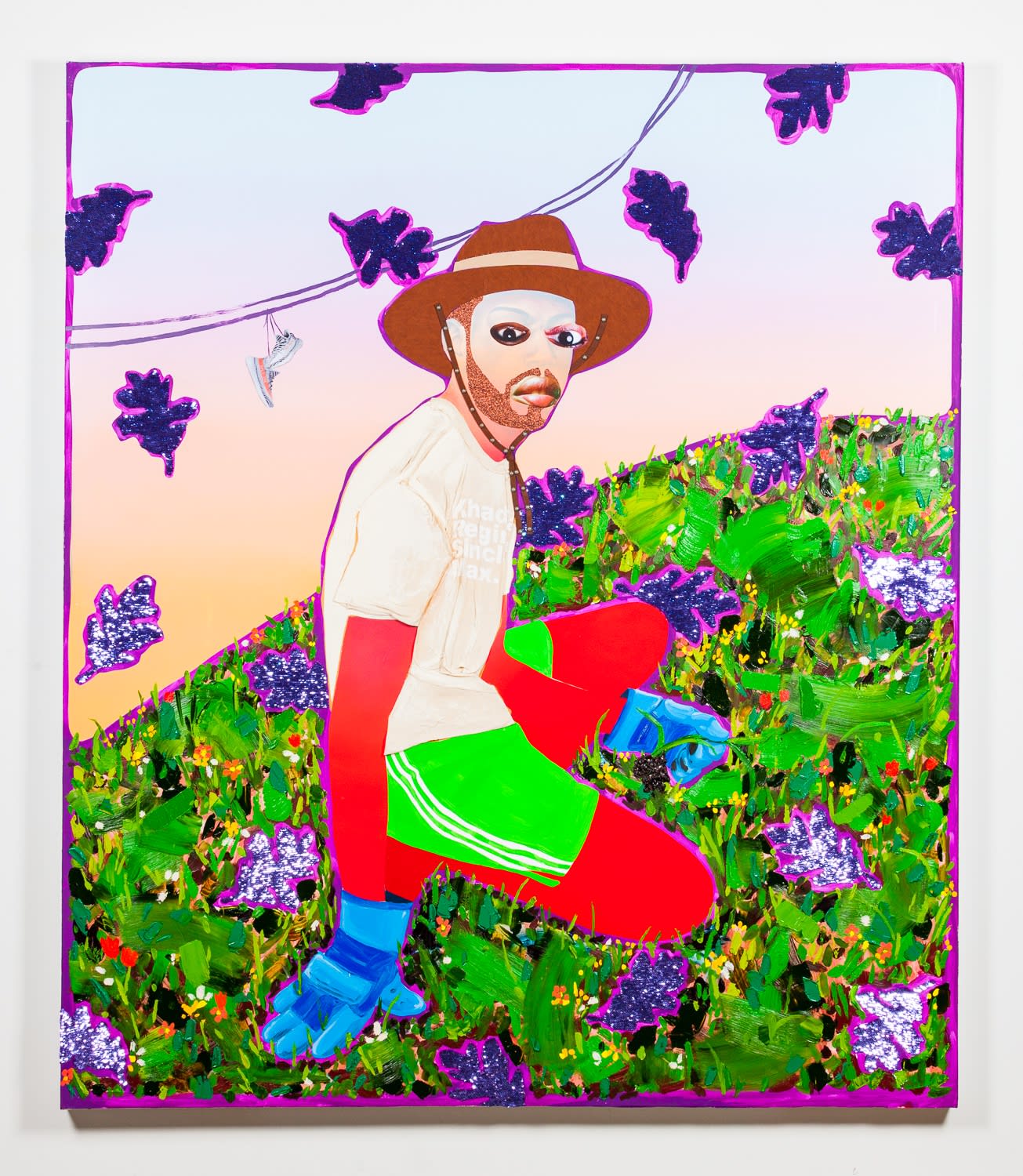
ONE TO WATCH: Inventing Male Archetypes that Privilege Softness and Introspection: Devan Shimoyama
Looking back at the Whitney Museum of American Art's landmark exhibition Black Male: Representations of Masculinity in Contemporary American Art (1994-95), Huey Copeland gravely observed: "'The black male' is a perennial site of fear and projection, policing and pathology, contestation and coalition." This was in 2014, the year Eric Garner was choked to death by a police officer in New York City, galvanizing the Black Lives Matter movement. No doubt Copeland was alluding to this in his comment, but it made me think of video and performance artist Ulysses Jenkins, whose pioneering explorations of Black masculinity in the 1960s and 1970s were not included in the Whitney exhibition. Jenkins, who honed in on the role of mass media, revealed not just how stereotypical depictions of Black men in popular culture were rooted in antebellum and Jim Crow-era caricatures, but how they were internalized - something he sought to resist. In the video Mass of Images (1978) he chants: "You're just a mass of images you've gotten to know / from years and years of TV shows. / The hurting thing, the hidden pain / was written and bitten into your veins / I don't and I won't relate / and I think for some it's too late!"
In many ways, I see Devan Shimoyama's Barbershop series (2017-18), which similarly underscores and resists this internalization, as a continuation of Jenkins' pursuits
albeit from the vantage of a twenty-first-century artist growing up Black and queer. But rather than embody the objectification endemic to ontological Blackness as Jenkins did, Shimoyama turns to the liberating potential of fantasy, inventing male archetypes that privilege softness, introspection, and joy instead. Known for psychedelic-hued portrait paintings that embellish flat areas of color with sequins, glitter, feathers, faux fur, photos, and rhinestones, the artist's take on the homophobic barbershops of his youth - places he often felt shamed and unsafe-imbue these memories with the power of femme transcendence: "Creating that fiction of glamour, of decadehce of wealth." he noted, "is something heavily ingrained in drag culture that always fascinates me, but it's also heavily ingrained into Black culture."

Devan Shimoyama, Bobby, 2019.

Devan Shimoyama, Gabi, 2019.
The life-size portraits depict their subjects wrapped in salon capes, their eyes alternately tender, apprehensive, and vacant. Each submits to hovering hands with clippers and razors that hold the promise of a fade, a flattop, or a night of disappointed tears. In many, those tears are already there, dripping down like cut diamonds from the corners of their eyes. The self-portrait Sit Still (2018) reimagines the artist's first haircut, a rite of passage transposed into adulthood as Shimoyama's golden beard suggests. Outsized eyes cut from photographs of female relatives - a recurring motif - float on the painted surface of his sun-kissed face. Two crystal teardrops affixed nearby echo the silver polka-dotted wallpaper and leopard-print cape that frames his face. Despite the tears, a sense of reverie and refuge prevails in the decorative world that he now occupies.
When Shimoyama showed these mixed-media paintings in his first solo museum exhibition, Cry, Baby, at the Warhol Museum in 2019, they were paired with his portraits of Miss Toto, a Miami based drag queen and bodybuilder, and two memorial swing sculptures devoted to Tamir Rice and Trayvon Martin. Together the works confronted viewers with their assumptions about Black masculinity, the silk-flower-covered playground swings of the latter reminding us that Rice, murdered by police at age twelve, and Martin, gunned down by a vigilante at age seventeen, were not men but in fact innocent boys. Shimoyama's ongoing Hoodie series (2017-present) also invokes the aesthetics of impromptu urban memorials - think ghost bikes and corner shrines - in their elegiac use of flowers. They are "emblematic of Black masculinity in a lot of dark and sad ways," the artist says. His repurposed hoodies are transformed into objects of fecund beauty festooned with brooches, roses, and rhinestones, among other materials. They are as much a form of purification as they are homage. A recent example, showing in the group show Garmenting: Costume as Contemporary Art (2021-22) at the Museum of Arts and Design in New York, was dominated by yellow- and peach-colored roses, lilies, and daffodils, among other silk flowers, and two swaths of fabric - one a tiger print, the other a sequined patch of lemon yellow. Titled February 11 (2019), the month of Martin's birth and death, it hung high on the wall, its outstretched, Christ-like arms beseeching us to remember.
"I keep returning to those two and thinking about them as children and the perception of them as men, '' Shimoyama shared. "I don't want people to forget that that happened.” Avoiding overt displays of sorrow and tragedy, the artist's strategy of metamorphosis through adornment is deliberate: "These works are anchors to reality without shoving in your face another triggering presentation or Black bodies in pain."
One of my favorite projects by Shimoyama is a series of portraits of readers titled Shh… (2018-19). Rendered largely in a fiery palette of hot pinks, reds, and yellows, it depicts Black figures in intimate settings entranced by the power of books. The various texts that appear within them advance a radical Black canon, and are as much the subject of the paintings as the characters who inhabit them. Here again, the artist envisions alternative worlds for his Black subjects, places of refuge - symbolized by the books and settings alike - where archetypes of searching and introspection are imagined.
Miles (2019) reveals a cropped male figure in a striated wife-beater, chin in hand, with enchanted eyes forged from gold jewels that beam at us. Behind him is a shelf of books, one of which is Rickey Laurentis's prize winning debut collection of poems, Boy with Thorns (2015), an imitate gender-queer memoir of sorts that limns the psychic consequences of hetero-masculinity.The poem Black Gentleman, the title of another work from Shimoyama's series, begins with a stanza that eerily echoes Jenkins's script from Mass of Images. "There are eyes, glasses even, but still he can't see / what the world sees seeing him. / They know an image of him they themselves created. / He knows his own fine-lined fron foot to finger, / each limb adjusted, because it's had to to achieve finally flight-.”

Devan Shimoyama, Weed Picker, 2018.
Shimoyama's recent work embodies this flight draw upon archetypes of classical mythology and astrol to center Black queer joy and resilience.The monstrous femme fatale Medusa, for example, is reconfigured as Sedusa (2021), a self-portrait in which the red face is overlaid with the lips of his mother. As the emerald-colored braids glittering with black spots into snakes, yellow hands press against temples imitating Shimoyama's struggles with migraines, In this version, the snakes come from ancient Hindi and Egyptian mythology where they are guardians and protectors of sacred space, not harbingers of evil. Tempérance (2022), inspired by Tarot decks, transforms the artist into a blue angel with a golden afro-styled halo who sits at the edge of a garden. Instead of pouring liquid from one receptacle to another like the traditional Tarot card in which waters mixed with wine to signify restraint, he empties a bottle of blue glitter into a field of flowers. As its endless bounty flows out to form a river, he gazes upward in a trance-like state as if channeling the abundance around him. It's an apt metaphor for Shimoyama's career at the moment, which continues to reap hope and renewal at a time when we all desperately need it.
Devan Shimoyama (1989, USA) lives and works in New York. His painting practice is rooted in explorations of his personal identity and experiences. Mobilizing mythology, spiritual tridaitons, and the compositional strategies of classical painters such as Francisco Goya and Caravaggio, he crafts heroic and sanguine depictions of the Black, queer, male body. Forthcoming exhibitions of Shimoyama’s work include: Oh, Gods of Dust and Rainbows at FRONT International Cleveland Triennial for Contemporary Art, Cleveland, through October 2,2022; and When We See Us at Zeitz MOCAA, Cape Town, opening in November 2022.

